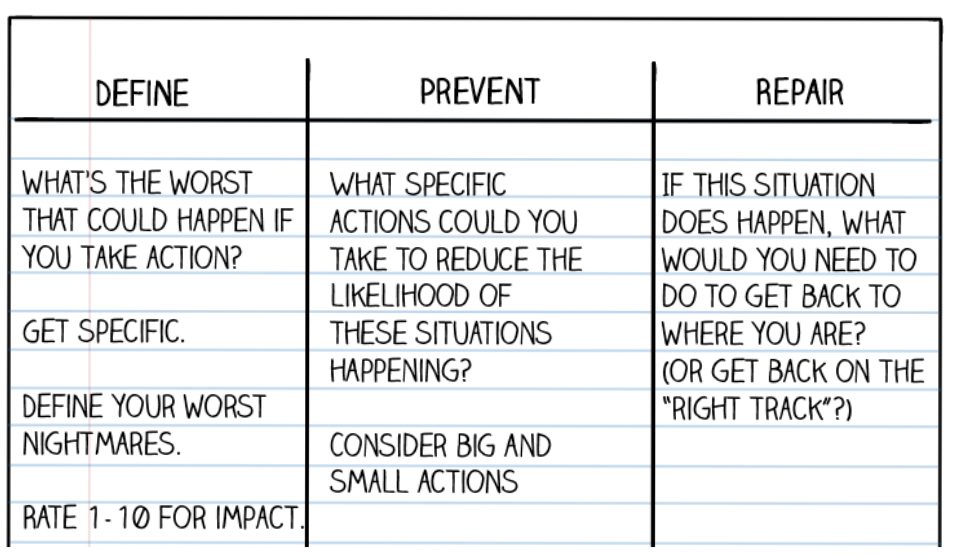Are you delaying your sustainability career change?
Is it fear? (Hint, probably yes)
You want to make an impact, you recognise the urgency of action. All around you people are coming together to ‘do their bit’ but something is holding you back.
Day to day you might notice resistance, experience overwhelm, fall prey to procrastination or simply avoid a difficult decision. It can feel like a big barrier weighing on your shoulders, or worse still an insidious nagging issue creeping into late night thoughts.
That thing is most likely to be rooted in FEAR. Fear of change. Fear of rejection. Fear of failure. Fear of being ‘found out’ as an imposter. Fear of the judgement from others. Even the obvious fear of losing your financial security.
We are all human, and we are biologically wired to fear change to some degree. Its just that isn’t always in our best interests now we are troglodites.
Fear tends to warp our thinking, causing us to…
Exaggerate the potential negative consequences of taking action.
Understate the potential positive results of taking action.
Ignore the costs of inaction.
But fear can be addressed, systematically and deliberately.
In a manner that will leave you feeling liberated and in control of your direction.
If you are prepared to put in an hour of reflection I’d love to share an exercise that will help. A nine-step process to:
Examine, identify, and minimise your fears
Establish positive outcomes of even partial success
Recognise the real risk of inaction and help you use that to get moving
What if the content you consume daily is shaping your career mindset more than you realize? Learn how to curate your inputs for positive change and stay motivated
2000 Years Of ‘Getting Over It”
Fear is nothing new. Seneca the younger - the Greek stoic philosopher, man of letters and all round awesome guy - recognised this and developed a practice to keep him flexible and manage his life perspective.
“Take part of a week in which you have only the most meagre and cheap food, dress scantly in shabby clothes, and ask yourself if this is really the worst that you feared.”
He was one of the richest men of his day and he saw the importance of exploring his blindside fears. This idea has been adopted and flexed for over two thousand years. There are even phone apps that help with versions of this such as the “ClearFear” app that helps us define and face our fears.
It is the act of identifying the source of fear, bringing it into the light, and examining it that helps us overcome and manage it.
Moving it out of Seneca's ancient realm into the reality of examined life. So let’s start and evolve an approach that may be more familiar to you.
Ever managed a project? A bit old school these days but enshrined in Prince 2 Project Management Methodology is the “issues and risks log”.
Designed to explore potential programme issues and give a degree of security before and during any program of change. A fear mitigation list if you will.
Sounding like something you could do with as you face your big decision?
However, we can take it a few steps further by including a consideration of the costs of inaction and the upside of action too.
Build Your Fear File
This is a structured reflection exercise used to help you see decisions more clearly when fear is holding you back and distorting your thinking.
Fear-Setting has three sections, each with a different purpose:
Put your fears under a microscope
Consider the potential benefits of taking action
Consider the consequences of inaction
In doing this work you are going to create a Fear File that you can build on and come back to whenever you feel a resistance in you
1. Define Prevent Repair
The first page of fear setting is about getting up close and personal with your fears.
Instead of shying away from thinking about it, you dive in head-first to understand them more clearly.
Step 1: On page one, make three columns and label them “Define”, “Prevent”, and “Repair”.
Page one of your FEAR FILE.
Step 2: In column one, define everything you fear about the idea of taking action. List out your most nightmarish scenarios, your doubts, and your “what-if”s. Write it all down, and don’t hold back. What’s the worst case scenario? What might go wrong?
Step 3: In column two, list ways you could reduce the likelihood of each of the worst-case scenarios from happening. What actions could you take to make those scenarios less likely to come to fruition? (Consider both big actions and small actions.)
Step 4: In column three, list ways you could repair the damage, if this situation were to come true.
What actions could you take to repair the damage, or get yourself back on track?
Step 5: Assess the impact of these worst-case scenarios on a scale of 1-10. (1 = minimal impact, and 10 = permanently life-altering in a significant way).
2. Consider The Potential Benefits of Taking Action
On page two of your fear file, give yourself space to be more open, and consider what might go right if you do take action.
Step 6: Write down the positive benefits even of an attempt, or partial success at taking action. What might you learn, who might you meet, what might it do for your frame of mind?
Page 2 of your FEAR FILE
Step 7: Assess the potential positive benefit of these successes on a 1-10 scale. (1 = minimal impact, 10 = a very significant impact.) Notice how even small “wins” on this path could be significantly impactful.
3. Consider the Consequences of Inaction
Page three is equally important to the others, but often forgotten : the costs of inaction.
Step 8: Make three columns on the page, and label them 6 months, 1 year, and 3 years.
Page 3 of your FEAR FILE
Step 9: Write down the potential costs of maintaining the status quo. What are the costs of inaction? What are the death bed regrets you might harbour if you don’t make a change?
Wondering if what you're experiencing is normal workplace stress or something worse? Get clarity on knowing when to stop—recognising toxic work environments and finding support
How Does It Feel
What does it feel like to have your fears on a page?
Good right?
It should do, much of the fear we hold is fear of the unknown, and when we explicitly face up to an uncertain future we can begin to manage our response.
So when you notice resistance, experience overwhelm, procrastination or hesitation, flip open your fear file (or make a new one for this moment) and push on through.
“May your choices reflect your hopes, not your fears”





